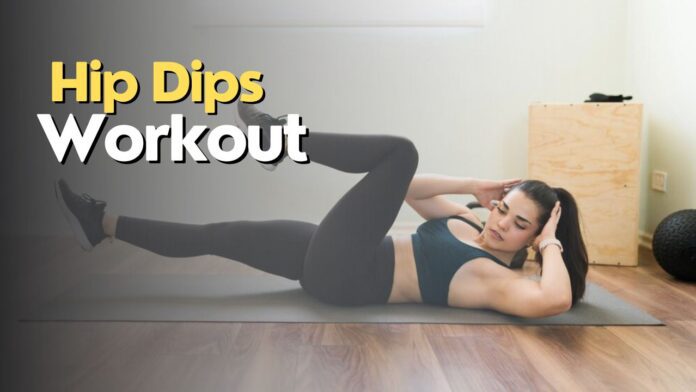Hip dips are a common anatomical characteristic found in many persons. They are the inward depressions on your side, just below your hip bone. Despite the fact that they are a normal part of the body, some people remain self-conscious about their look. Fortunately, there are workouts that can help tone the muscles surrounding the hips and lessen the look of hip dips.
Hip dip appearance is heavily influenced by skeletal architecture and heredity. Certain workouts, on the other hand, can assist target the muscles surrounding the hips and minimize their appearance. Muscle building in the glutes and thighs can help you look more rounded and toned. While these exercises can help lessen the appearance of hip dips, they may not fully eradicate them.
This post will look at some of the greatest exercises for hip dips and toning the muscles around the hips. We will also go over the anatomy of hip dips and how heredity influences their appearance. Whether you want to increase your overall health and fitness or lessen the appearance of hip dips for aesthetic reasons, these exercises can be a terrific addition to your workout program.
Understanding Hip Dips Workout:
Hip dips are the inward curves or indentions that some people have between the hip and the thigh. This is due to the pelvic shape and structure, as well as the way the femur (thigh bone) joins to it. In this section, we will delve more into the anatomy of hip dips, as well as the causes and variables that lead to them, as well as debunk some widespread misunderstandings about them.
Anatomy of Hip Dips
The hip dips are caused by the form of the pelvis, which varies from person to person. The pelvis is a bone structure that connects the spine to the femur, and its shape is determined by heredity. The femur may attach at a slightly different angle due to the curve of the pelvis, resulting in a dip or indentation between the hip and the thigh.
The gluteus medius muscle, placed on the outside of the hip, also contributes to the appearance of hip dips. This muscle joins to the top of the femur and aids in hip joint stability. A weak or undeveloped gluteus medius might lead to the appearance of hip dips.
Causes and factors
While the shape of the pelvis is the most important factor in determining the appearance of hip dips, other variables might also contribute to their development. Fat distribution is one of these factors. Hip dips can be accentuated if a person has a tendency to carry more fat in their hips and thighs.
Another aspect that can contribute to the appearance of hip dips is skeletal structure. Some people have larger hips or a more pronounced pelvic curvature, resulting in a more visible indentation between the hip and the thigh.
Myths vs. Reality
There are various myths about hip dips that must be debunked. One of these beliefs is that hip dips indicate that you are overweight or unwell. This is not correct. Hip dips are a normal feature of the skeletal system that can be found in people of different shapes and sizes.
Another common misconception is that hip dips can be removed by exercise or diet. While exercise can assist to strengthen the gluteus medius muscle and improve general muscle tone, it cannot alter the pelvic shape. Similarly, nutrition and weight loss have no effect on the basic structure of the bones.
Finally, hip dips are a naturally occurring hereditary component of the skeletal system. While exercise and diet can assist to enhance muscle tone and general look, they cannot affect the pelvic form. Individuals can learn to love their distinct body shapes and feel secure in their own skin by studying the anatomy and variables that contribute to hip dips.
Advantages of Hip-Dips Workout

Hip dips are a natural component of the human anatomy, and while they are totally normal, some people may be self-conscious about them. Hip dip exercises can assist to minimize the appearance of hip dips and create a more defined hourglass shape. Hip dip exercises, in addition to providing aesthetic benefits, also give muscle strengthening, increased stability, and balance.
Aesthetic Improvement
Hip dips exercises can aid in the development of a more defined hourglass shape, which is a desirable body shape for many people. Hip dips exercises, which target the muscles in the hips and thighs, can help to lessen the appearance of hip dips and provide a smoother, more contoured appearance. While hip dip exercises cannot eradicate hip dips altogether, they can help to improve the overall appearance of the hips and thighs.
Muscle Strengthening
Hip dips exercises can also aid to develop the hip and thigh muscles. Individuals can improve their overall muscle tone and strength by targeting these muscles. Muscle strength can also aid in improving posture and lowering the chance of injury during physical activity.
Enhanced Stability and Balance
Hip dips exercises can also aid with balance and stability. Individuals can enhance their general balance and coordination by addressing the muscles in their hips and thighs. This is especially useful for people who participate in sports or other physical activities that necessitate a high level of balance and coordination.
Finally, hip dips exercises have a variety of benefits, including improved aesthetics, muscle strengthening, and increased stability and balance. Incorporating hip dips exercises into a regular training regimen can help people create a more defined hourglass shape, increase overall muscular tone, and lessen the chance of injury when exercising.
Targeted Exercises for Hip Dips
Hip dips are a frequent human body feature. They are a normal occurrence and pose no health dangers. Some people, however, may be self-conscious about their appearance. Fortunately, there are a number of exercises that might assist in reducing the look of hip dips.
Squats and Variations
Squats are one of the most effective workouts for glute and hip strength. The gluteus maximus, gluteus medius, gluteus minimus, and tensor fasciae latae muscles are worked. This helps to lift and tone the hips, making hip dips less visible.
Squat variations that can be beneficial for hip dips include:
- Sumo squats
- Bulgarian split squats
- Curtsy lunges
Lunges and Variations
Lunges are yet another excellent exercise for working the glutes and hips. They engage the same muscles as squats, but in a different manner. Lunges can help tone and contour the hips, making hip dips less visible.
Lunge variations that can be beneficial for hip dips include:
- Reverse lunges
- Side lunges
- Walking lunges
Glute Bridges and Variations
Glute bridges are an excellent workout for focusing on the glutes and hamstrings. They can help to raise and tone the hips, making hip dips less visible. Glute bridges engage the gluteus maximus and hamstrings, two key muscles for hip strength.
Glute bridge modifications that can aid with hip dips include:
- Single-leg glute bridges
- Banded glute bridges
- Hip thrusts
Side Leg Lifts and Variations
Side leg lifts are an excellent way to target the gluteus medius muscle. This muscle is vital for hip stability and can assist prevent hip dips. Side leg lifts can be performed with or without equipment and are a simple addition to any training plan.
Some side leg lift variations that can help with hip dips are as follows:
- Clamshells
- Side hip openers
- Fire hydrants
- Donkey kicks
These exercises, when incorporated into a training plan, can assist to strengthen the hips and lessen the appearance of hip dips. It’s crucial to note that hip dips are a natural occurrence and should not be taken seriously. Individuals might feel more confident and comfortable in their own bodies by focusing on hip-strengthening workouts.
Workout Accessories and Equipment
When it comes to working out, having the proper equipment and accessories may make or break your workout. A variety of equipment and accessories can be utilized to supplement hip dip routines. This section will go over the advantages of employing resistance bands, dumbbells, and ankle weights.
Utilizing Resistance Bands
Hip dip workouts benefit greatly from the use of resistance bands. They create resistance, which can aid in the strengthening and toning of the muscles in the hip dips area. Resistance bands are available in a variety of levels, making them appropriate for persons of various fitness levels.
Resistance bands are portable and may be used anywhere, which is one of their advantages. They can be utilized at home, the gym, or even on the road. Resistance bands can be used to do exercises such as clamshells, fire hydrants, and lateral leg lifts.
Incorporating Dumbbells
Dumbbells are an additional useful instrument for hip dip routines. They can be used to increase the resistance of workouts like squats, lunges, and deadlifts. Dumbbells are available in a variety of weights, making them suited for persons of all fitness levels.
Dumbbells can aid to boost the intensity of a workout, resulting in better outcomes. Dumbbells can also be utilized to target other parts of the body, such as the arms and shoulders.
Ankle Weights and Their Benefits
Ankle weights are an excellent addition to hip dip routines. They are useful for adding resistance to workouts like lateral leg lifts and donkey kicks. Ankle weights are available in a variety of weights, making them appropriate for persons of all fitness levels.
The use of ankle weights might aid to raise the intensity of the training, resulting in greater results. They can also be used to target other body parts, such as the glutes and thighs.
Finally, using the proper equipment and accessories can aid improve hip dip workouts. Resistance bands, dumbbells, and ankle weights are all excellent tools for adding resistance and increasing the intensity of a workout. It is critical to select workout equipment and accessories that are appropriate for your fitness level and goals.
Creating a Hip Dips Workout Plan
Hip dips are a natural feature of many people’s anatomy, however other people may seek to lessen their appearance through training. A hip dips training regimen can assist to strengthen the muscles that surround the hips and thighs, resulting in a more toned and defined appearance.
Weekly Exercise Regimen
It is critical to maintain a consistent weekly exercise regimen while developing a hip dips workout plan. Squats, lateral leg lifts, and hip dips are examples of such workouts. A healthcare expert or personal trainer can assist in developing a personalized workout plan based on personal fitness objectives and existing fitness levels.
It is advisable to exercise at least three times per week, with each workout lasting 30 minutes to an hour. Incorporating both strength training and cardio will help you achieve your goals and improve your overall health.
Exercise Progression
As with any fitness program, progressively increasing the intensity and complexity over time is critical. This can be accomplished by raising the weight or resistance used during exercises, or by adding more reps or sets.
It’s critical to listen to your body and avoid pushing yourself too hard, as this might lead to damage. A progressive rise in difficulty can aid in injury prevention and long-term success.
Monitoring Results
Monitoring results is essential for tracking development and making any changes to the workout plan. This can be accomplished by taking before and after images, taking body measurements, or simply keeping track of how many reps or sets are completed throughout each workout.
Individuals can examine how their bodies are responding to the workout plan by monitoring results and making adjustments as needed to attain their fitness goals. It’s also critical to listen to your body and make modifications if you suffer any pain or discomfort when exercising.
Finally, with specific movements, a hip dips workout regimen can help lessen the appearance of hip dips. Individuals can attain their fitness objectives and enhance their overall health by adopting a consistent weekly exercise plan, implementing exercise progression, and tracking results.
Nutrition and Lifestyle for Reducing Hip Dips
Dietary Considerations
Nutrition is extremely important in preventing hip dips. A nutrient-dense, well-balanced diet can help you eliminate extra body fat and gain lean muscle mass. Consuming meals that are low in calories but high in protein, fiber, and healthy fats is critical.
Protein is a macronutrient that is necessary for muscle growth and repair. It also makes you feel fuller for a longer period of time, which might help you avoid overeating. Protein-rich foods include lean meats, fish, eggs, beans, and legumes.
Another important vitamin that can help decrease hip dips is fiber. It makes you feel full and satisfied, which can help you avoid overeating. Fruits, vegetables, whole grains, and legumes are all high in fiber.
Healthy fats, such those found in nuts, seeds, avocados, and olive oil, can also help reduce hip dips. They can make you feel full and satisfied, which can help you avoid overeating.
Importance of Overall Fitness
Aside from a good diet, overall exercise is essential for decreasing hip dips. Exercise on a regular basis can help you eliminate excess body fat and build lean muscular mass. To achieve the best results, mix cardiovascular activity with strength training.
Cardiovascular exercise, such as jogging, biking, or swimming, can aid in the burning of calories and the reduction of body fat. Strength training, such as weightlifting or bodyweight exercises, can assist in the development of lean muscle mass.
It is also critical to live a healthy lifestyle in general. Getting enough sleep, managing stress, and refraining from smoking and excessive alcohol intake can all help to reduce hip dips.
Finally, reducing hip dips necessitates a mix of a good diet and overall fitness. You can shed extra body fat and build lean muscle mass by eating a well-balanced diet high in protein, fiber, and healthy fats and engaging in regular aerobic exercise and strength training. Maintaining a healthy lifestyle in general can also help to reduce hip dips.
Common Questions and Expert Advice
Addressing Hip Dip Concerns
Hip dips are a natural bodily contour that occurs when the hip meets the thighs below the hip bone. Some people are self-conscious about their hip dips and ask if there are any workouts that will help them seem better.
One frequently asked question is whether hip dips can be eliminated. No, it does not. Hip dips are a natural aspect of the human structure and cannot be totally avoided. There are, however, workouts that can assist build strength around the hip area, reducing the look of hip dips.
Another question is if it is feasible to naturally and quickly increase muscle around the hip area. Yes, it is possible to gain muscle naturally; however, it may take some time and consistency. To efficiently gain muscle, a well-balanced diet and frequent exercise are required.
Professional Insights
Certain workouts, according to healthcare professionals and personal trainers, can assist strengthen muscle around the hip area and lessen the look of hip dips. Standing leg lifts, side planks with leg lifts, squats, and lunges are among the exercises.
It is crucial to remember that, while these workouts can aid in muscle development, they may not fully eradicate hip dips. Additionally, before beginning any new workout plan, contact with a healthcare practitioner or personal trainer, especially if you have any underlying health concerns or injuries.
Finally, hip dips are a natural feature of the body’s architecture and cannot be fully eliminated. Exercises, on the other hand, can assist build muscle around the hip area and lessen the appearance of hip dips. Before beginning any new fitness plan, it is critical to consult with a healthcare practitioner or personal trainer.
Conclusion
Finally, hip dips workouts might help you attain a more contoured and confident shape by reducing the appearance of hip dips. While hip dips are a natural feature of skeletal architecture and are nothing to be ashamed of, some people may be self-conscious about them.
Individuals can reduce the appearance of hip dips by adding core-strengthening exercises, corrected side hip movements, and targeted workouts. Collagen supplements and supportive tools can also provide nutritional support and assist individuals in achieving their ideal body form.
It should be noted, however, that there is no certainty that hip dips exercises will fully eliminate hip dips. Body form and confidence are complex and varied concepts, and it is critical to emphasize general health and well-being over acquiring a specific body shape.
Finally, people should approach hip dips exercises with a balanced and realistic mentality, realizing that they can be a useful tool in developing a more confident and healthier body but are not a panacea for all body image issues.




![How Much is Lil Baby’s Net Worth in 2024 [Latest Info] Lil Baby Net Worth](https://www.wariat.org/wp-content/uploads/2024/03/Lil-Baby-Net-Worth-150x150.jpg)
![Rob Lowe Net Worth Speculation in 2024 [Comparative Analysis] Rob Lowe Net Worth](https://www.wariat.org/wp-content/uploads/2024/03/Rob-Lowe-Net-Worth-150x150.jpg)

